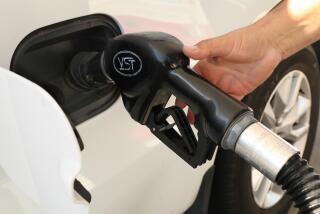Gas Prices Drive Home an Old Point
- Share via
Commuters shuttling to jobs 100 miles away via 200-passenger aerial buses. Does that sound like some futuristic flight of fancy overheard at one of those visioning events taking place from Simi Valley to Ventura?
Actually, this prediction (for the year 2000) turned up in a 1950 issue of Popular Mechanics, published at a time when gasoline was 27 cents a gallon and a quart of milk was 22 cents.
Fifty years ago, Ventura County, dotted by modest municipalities sprouting up amid seemingly boundless corridors of crops, defined itself as one of the most abundant agricultural areas in all of California. Then came the freeway and life on the Gold Coast was radically altered. The population bulged tenfold and a Pandora’s box of unfettered development cracked wide open thanks to inexpensive gasoline.
Today, Californians are fuming--a condition that can only be described as a chronic pain in the gas tank. The retail price of petrol has jumped 51 cents a gallon since late February, a veritable bonanza for Big Oil. A couple of Northern California refinery explosions (Chevron and Tosco), an OPEC oil cartel compact to curtail production, and the seasonal spring spike are being blamed for fueling the increase.
Big girls (and I’m not just talking about Randy Valli) do cry as they attempt to fill their gas-guzzling SUVs. Fuel-efficient imports are starting to entice the eye of auto mall-crawlers once again. Smug souls tooling around in electric cars aren’t a bit shocked that foul fossil fuel users are finally getting their well-deserved comeuppance.
A populist effort that calls itself (I’m not making this up) “Gouging America Stinks” (GAS), is forwarding e-mail to thousands of Internet users claiming that “gas prices are rising despite millions of gallons in storage” and that production is being deliberately slowed. Recipients are invited to participate in a boycott, aptly named the “Great Gas Out,” on Friday.
*
Like Howard Beale in the 1976 film “Network,” these electronically conspicuous consumers are mad as hell and are not going to take it anymore. Their cyber-alarm has certainly resounded in the bedroom communities of Ventura County, where the average commute is 24.7 minutes. In east county cities such as Simi Valley, 50% travel over the hill to work.
Look up. Do you see any 200-passenger aerial buses? Richard Anderson, who teaches a course on the human future at UC Santa Barbara, contends: “What we are looking at here is Tyrannosaurus Rex in the flesh.” He predicts that gas prices will spiral to $5-$10 a gallon within the next decade with “radical stresses and dislocations in the American economy and society.” Gulp. Not even the Jaws of Life will be able to extricate us from this wreck.
According to the Ventura County Transportation Commission, transit system users are on an almost imperceptibly slow growth (and / or learning) curve. Only about 20% of Ventura County commuters ride-share or use public transportation. The Guaranteed Ride Home program, which provides an emergency backup for commuters, has not overcome the attitudinal barrier that keeps folks codependent on their cars.
With respect to making Metrolink (the commuter rail system serving Simi Valley, Moorpark, Camarillo and Oxnard) more commuter-friendly, it would seem that Ventura County has the inside track. Simi Valley Mayor Bill Davis was tapped last January as the new chairman.
Although Il Duce would be proud that reportedly 90% of Ventura County trains run on time, not enough of us have chosen to become daily passengers despite the economic bargain (downtown parking fees are nearly double the cost of a monthly pass), or the obvious stress-busting plus.
*
Don’t expect a merely symbolic one-day boycott to effect any sort of price reduction. Only withholding patronage for an extended period of time or retarding the rate of consumption (e.g. ride-share or public transportation) is going to make a discernible difference.
At least milk prices have gotten easier to swallow. Grocery stores are advertising a 50-cent-per-gallon decrease (no mere drop in the bucket). So if you really want to save money on that milk mustache, do your body good. Leave your clunker in the carport.






